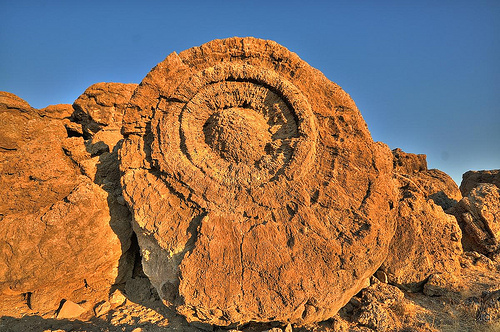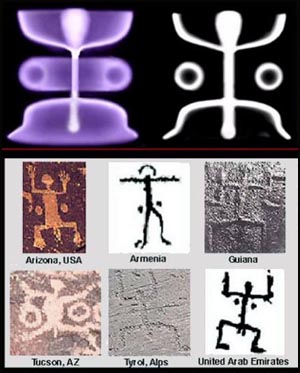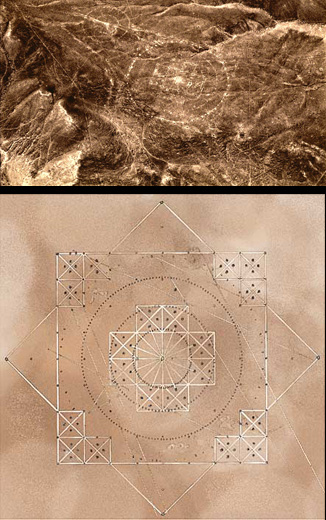

What Clovis saw:
Plasma columns and Z-pinches in the sky!
The northern lights are an example of how "sparks" of plasma can form luminous, electrically charged sheets or "tubes" at the Earth's poles. The aurora, as it is called, occurs when mild energy from our Sun is trapped and dissipated by the Earth's magnetic poles. An even higher energy source would create a uniquely shaped discharge that would be visible in the sky in daytime and persists for years.
 Extremely high energy -- the type that would have caused the Moon glass and zapped the Earth -- creates an elaborate discharge. Physicists call it a z-pinch formation.
Extremely high energy -- the type that would have caused the Moon glass and zapped the Earth -- creates an elaborate discharge. Physicists call it a z-pinch formation.
The z-pinch has been extensively researched by a group headed by Anthony L. Peratt with the Los Alamos National Laboratory, Los Alamos, NM and is described in his paper, Characteristics for the Occurrence of a High-Current Z-Pinch Aurora as Recorded in Antiquity Part II: Directionality and Source[5]. In this paper, Dr. Peratt illustrates the shape and characteristics of this high energy discharge on the Earth and shows thousands of petroglyph sites all over the globe where this z-pinch was observed and recorded in ancient carvings.
The term z-pinch originates from experiments where physicists made extremely high current to flow through thin wires that were arranged vertically in a tubular formation. They noticed that the energy quickly vaporized the wires, but the magnetic field generated by these paths remained and contained (or "pinched") the stream of energy, collapsing the streams of energy toward the center of the tube-like configuration -- called the z-axis. When the streams of energy converge, they form unique shapes that persist and can be observed as Birkeland elements, named for their discoverer.

[Above (left): Virtual image of the intense auroral plasma column as viewed at an angle of inclination, not to scale. Above (right): Conceptual view of the Birkeland sheath filaments surrounding Earth (28 close pairs). The relativistic electron flow is downwards toward Antarctica. The current bundle above Antarctica twists in counter-clockwise rotation. By convention, the Birkeland currents and ion flow is upwards toward the Arctic. Not yet completely resolved is a bend in the upper filament sheath that allows the upper plasmoids and column to be seen at northern latitudes.]
If the Earth was zapped by high energy radiation, either from the Sun or the Galactic core, the planet would be surrounded with distinct lines of energy, converging at the North and South pole. These bands would continue to extend well out from the planet's poles and into space and would be visible from almost every point on Earth -- each with its own unique perspective.

Laboratory experiments whith a metal sphere, representing Earth, show the "chalice" shape created by high energy paths [above]. Oddly, repeated experiments show a preference for 56 "rays" or distinct bands of energy. This same number is often depicted in the ancient petroglyphs!

[Above (left): Northern hemisphere petroglyphs from the Columbia River Basin, 45.65ºN, 121.95ºW. Right: Oblique view into the auroral plasma column from these coordinates. Above (right): Nasca, Peru vase, date unknown (14.24ºS, 75.58ºW). Note the similarity to the northern hemisphere petroglyphs.]

These simulations from the Lawrence Livermore National Laboratory show the unique shapes that the plasma filaments make as they encircle the earth. Here are the Nevada petroglyphs again for comparison.

Recent archiving of global petroglyphs has demonstrated that these shapes were correctly recorded in rock carvings by humans who witnessed this event!

[Above (left): White-striped pictographs at Iga Warta Cultural Tourism Centre, North Flinders Range (30.59ºS, 138.94ºE). Shown is Cliff Coulthard, Australian Department of Environment and Planning in Aboriginal Heritage, an authority on pictograph painting techniques having analyzed such works as the Magdalenian cave art in France. Above (right): Lightning Brothers, Ingaladdi, Victoria River, Wardaman country of the Northern Territory (15ºS, 130ºE). New dating techniques of this red inorganic-pigmented pictograph image were done using a plasma-chemical extraction method and correspond to the era of the z-pinch.]

When researchers went to various petroglyph sites that contained the z-pinch artifacts they carefully plotted the GPS location and noted if the ancient artist had a clear view of the Southern horizon. Almost all of the sites had this view. The number and extent of these global petroglyph sites clearly demonstrate the purpose of this art. Also, depending on the latitude, depictions of the z-pinch corresponded to the exact perspective that would have been expected.





Some examples of z-pinch petroglyphs are shown here. We highly recommend reading the complete article. We especially thank team member, John McGovern, for bringing this important work to our attention.

What does it all mean?
The new discovery validates the age of a certain style of petroglyph. It has surprised many archaeologists who believed them to be thousands of years younger. The estimated carving took place around 10,800 BCE, or 12,800 years ago. This coincides with the extinction of Clovis culture in Western North America.
Ice core data and lunar soil samples point to a large ejection of solar material (possibly a Coronal Mass Ejection) mixed with cosmic dust which hit Earth around 10,800 BCE. The impact of this huge discharge around our planet would have created unique shapes of glowing plasma, visible to the inhabitants for many years.
The time coincides with mass extinctions of mammals and so it is assumed that the event was not benign and that human survival was put to the test.
Experiments with plasma discharges in laboratories indicates that these unique shapes are recorded accurately in the 12,800 year old petroglyphs in Nevada, Colorado and elsewhere.
There is ample evidence to support the theory from hundreds of petroglyph sites around the globe. Each site records the plasma event according to the unique angle of observation.
A system of phonetic sound symbols (an alphabet) has been associated with these older petroglyphs and reasonably successful translations, using an archaic form of proto-Canaanite, describe the need to take shelter, a "painful" vertical light and "poison" from the sky. These repeating symbols seem to indicate that a language and crude writing system existed at that time.
Certainly, more research and interest is needed.
UPDATE: October 2016 -- The author recently visited the Paiute Indian Reservation in Pyramid Lake, Nevada, hoping to visit and look at the ancient petroglyphs mentioned in this story. Amazingly, the tribe has not only prohibited anyone from visiting the site but they have taken complete control of the research, requiring anyone curious about this historic collection of petroglyphs submit forms, resumes, research objectives and also to sign a contract with the tribe which allows them to have final say as to the conclusions of any research! All this (and undoubtedly some steep application fee$) just to look at them!
Imagine, something so important to the history of all mankind being restricted because of tribal pride and, well, just because they can. This is similar to the inhibitions placed on research into the famous Kennewick Man remains found in Washington State.
While it is necessary to prevent damage from graffiti and vandalism, restricting access to something that belongs to all humanity -- not just to a tribe that wasn't even on the continent 12,400 years ago -- seems racially based and inappropriate.
Fortunately, before the tribe realized they could ca$h in on these petroglyphs, many great photographs were taken and are freely available on the internet. Indeed, the true meaning of these petroglyphs has already been well established.
When asked how many people have successfully applied, paid fees and have been allowed to examine the site since these strict regulations were imposed, a representative of the tribe stated, "Just one."

[1] Gold, T. "Apollo II Observations of a Remarkable Glazing Phenomenon on the Lunar Surface." Science 165 (1969):1345.
[2] Excerpt from Paul LaViolette's 1983 Ph.D. dissertation, "Galactic Explosions, Cosmic Dust Invasions, and Climate Change."
[3] Morgan, Laul, Ganapathy, and Anders (1971 Morgan, J. W., Laul, J. C., Ganapathy, R., and Anders, E. "Glazed Lunar Rocks: Origin by Impact." Science 172(1971):556
[4] Zook, H. A., Hartung, J. B., and Storzer, D. "Solar Flare Activity: Evidence for Large Scale Changes in the Past." Icarus 32(1977):106
[5]Anthony L. Peratt, Fellow, IEEE, John McGovern, Alfred H. Qoyawayma, Life Member, IEEE, Marinus Anthony Van der Sluijs, and Mathias G. Peratt, Member, IEEE, "Characteristics for the Occurrence of a High-Current Z-Pinch Aurora as Recorded in Antiquity Part II: Directionality and Source," IEEE Transactions on Plasma Science, Vol. 35, NO. 4, August 2007.
[6] Markus Landgraf, Max Plank Institute.
[7] www.viewzone.com/comanche2.html -also- www.viewzone.com/firsttongue.yemen.html -also- www.viewzone.com/oklahoma11.html
One of the most universal petroglyph shapes for the period 10,800 BCE is what has been called the "stickman" or "squatting man" by archaeologists [below].

Dr. Peratt and his team have discovered that this shape, especially when depicted with two "dots" or circles on each side of the mid-torso, is recreation of what was seen in the sky of a huge plasma discharge.
The plasma event of 10,400 BCE was huge and went through many different variations as the energy dissipated. The "stickman" is but one of these phases. At other times, pairs of plasma filaments encircled the planet from the North to South Poles. The plasma column extended into space for thousnds of miles at the South Pole but was visible to inhabitants in the Northern hemisphere.
56 filaments appear repeatedly

Curiously, there are 56 points in this huge circular design that was carved into the desert near the Nazca lines in Peru. Did the ancients perhaps know something about the "event"?
The Plasma Tree: A world wide phenomenon

Petroglyphs from all over the world, made during the "event" (about 10,800 BC) depict a shape that reminds archaeologists of a tree.
Click Here to see larger picture of the Paraguay petroglyphs. Note the white arrows depicting the familiar shapes.

Devoid of leaves, the shape is believed to be a representation of a phase in the plasma discharge where several (seven is the preferred number) plasma toroids arrange themselves around a central shaft. Viewed from certain locations on earth, this shape would have resembled exactly what is depicted in the ancient petroglyphs.
What exactly is plasma?
From Wikipedia, the free encyclopedia
Plasma (from Greek meaning "anything formed") is one of the four fundamental states of matter (the others being solid, liquid, and gas). Heating a gas may ionize its molecules or atoms (reducing or increasing the number of electrons in them), thus turning it into a plasma, which contains charged particles: positive ions and negative electrons or ions. Ionization can be induced by other means, such as strong electromagnetic field applied with a laser or microwave generator, and is accompanied by the dissociation of molecular bonds, if present. Plasma can also be created by the application of an electric field on a gas, where the underlying process is the Townsend avalanche.
The presence of a non-negligible number of charge carriers makes the plasma electrically conductive so that it responds strongly to electromagnetic fields. Plasma, therefore, has properties quite unlike those of solids, liquids, or gases and is considered a distinct state of matter. Like gas, plasma does not have a definite shape or a definite volume unless enclosed in a container; unlike gas, under the influence of a magnetic field, it may form structures such as filaments, beams and double layers.
Some common plasmas are found in stars and neon signs. In the universe, plasma is the most common state of matter for ordinary matter, most of which is in the rarefied intergalactic plasma (particularly intracluster medium) and in stars. Much of the understanding of plasmas has come from the pursuit of controlled nuclear fusion and fusion power, for which plasma physics provides the scientific basis.